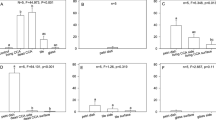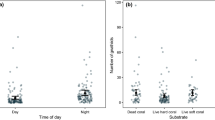Abstract
Microhabitat associations are considered to be important for juvenile survivorship and growth of coral reef fishes. The aim of the study was to quantify microhabitat associations between juvenile and adult white-streaked grouper Epinephelus ongus, which supports important fisheries in coral reef areas. Underwater observations revealed that most juveniles were found in bottlebrush Acropora spp., staghorn Acropora spp. and coral rubble and there was a significant positive use of bottlebrush Acropora spp. and a significant negative use of coral rubble. For adults, most individuals were found in bottlebrush Acropora spp. and staghorn Acropora spp., and there was a significant positive use of staghorn Acropora spp. and significant negative use of coral rubble. A habitat choice experiment by using pre-settlement individuals revealed that both bottlebrush Acropora spp. and staghorn Acropora spp. were used as settlement sites, whereas coral rubble was rarely used as a settlement site. Results of the study suggest that juvenile and adult E. ongus showed significantly positive microhabitat associations with bottlebrush Acropora spp. and staghorn Acropora spp., respectively, in the field. Bottlebrush Acropora spp. has smaller inter-branch spaces than staghorn Acropora spp., which could drive patterns of microhabitat associations. In addition, post-settlement processes such as predation may influence the spatial distribution of juveniles. Because Acropora corals are very susceptible to coral bleaching, we predict that rising temperatures from climate change will negatively impact populations of E. ongus.





Similar content being viewed by others
References
Almany GR (2004) Does increased habitat complexity reduce predation and competition in coral reef fish assemblages? Oikos 106:275–284
Beets J, Hixon MA (1994) Distribution, persistence and growth of groupers (Pisces: Serranidae) on artificial and natural patch reefs in the Virgin Islands. Bull Mar Sci 55:470–483
Beukers JS, Jones GP (1997) Habitat complexity modifies the impact of piscivores on a coral reef fish population. Oecologia 114:50–59
Booth DJ, Wellington G (1998) Settlement preference in coral-reef fishes: effects on patterns of adult and juvenile distributions, individual fitness and population structure. Aust J Ecol 23:274–279
Craig MT (2007) Preliminary observations on the life history of the white-streaked grouper, Epinephelus ongus, from Okinawa, Japan. Ichthyol Res 54:81–84
Dahlgren CP, Eggleston DB (2001) Spatio-temporal variability in abundance, size and microhabitat associations of early juvenile Nassau grouper Epinephelus striatus in an off-reef nursery system. Mar Ecol Prog Ser 217:145–156
Dixson DL, Munday PL, Jones GP (2010) Ocean acidification disrupts the innate ability of fish to detect predator olfactory cues. Ecol Lett 13:68–75
Dixson DL, Munday PL, Pratchett M, Jones GP (2011) Ontogenetic changes in responses to settlement cues by Anemonefish. Coral Reefs 30:903–910
Doherty PJ (2002) Variable replenishment and the dynamics of reef fish populations. In: Sale PF (ed) Coral reef fishes. Academic Press, San Diego, pp 327–355
Doherty PJ, Fowler AJ (1994a) An empirical test of recruitment limitation in a coral reef fish. Science 263:935–939
Doherty PJ, Fowler AJ (1994b) Demographic consequences of variable recruitment to coral reef fish populations: a congeneric comparison of two damselfishes. Bull Mar Sci 54:297–313
Donaldson TJ (2002) Habitat association and depth distribution of two sympatric groupers of the genus Cephalopholis (Serranidae: Epinephelinae). Ichthyol Res 49:191–193
Eggleston DB (1995) Recruitment in Nassau grouper Epinephelus striatus: post-settlement abundance, microhabitat features and ontogenetic habitat shifts. Mar Ecol Prog Ser 124:9–22
Flynn AJ, Ritz DA (1999) Effect of habitat complexity and predatory style on the capture success of fish feeding on aggregated prey. J Mar Biol Assoc UK 79:487–494
Gardiner NM, Jones GP (2005) Habitat specialisation and overlap in a guild of coral reef cardinalfishes (Apogonidae). Mar Ecol Prog Ser 305:163–175
Green LA (1996) Spatial, temporal and ontogenic patterns of habitat use by coral reef fishes (Family Labridae). Mar Ecol Prog Ser 133:1–11
Gutiérez L (1998) Habitat selection by recruits establishes local patterns of adult distribution in two species of damselfishes: Stegastes dorsopunicans and S. planifrons. Oecologia 115:268–277
Heemstra PC, Randall JE (1993) FAO species catalogue. Vol. 16: Groupers of the World (Serranidae, subfamily Epinephelinae). An annotated and illustrated catalogue of the grouper, rockcod, hind, coral grouper and lyretail species known to date. FAO, Rome, p 522
Hixon MA (1991) Predation as a process structuring coral reef fish communities. In: Sale PF (ed) The ecology of the fishes on coral reefs. Academic Press, San Diego, pp 475–508
Hixon MA (2011) 60 years of coral reef fish ecology: past, present, future. Bull Mar Sci 87:727–765
Hixon M, Beets JP (1993) Predation, prey refuges, and the structure of coral-reef fish assemblages. Ecol Monogr 63:77–101
Jones GP (1991) Postsettlement processes in the ecology of coral reef fish populations: a multifactorial perspective. In: Sale PF (ed) The ecology of fishes on coral reef fishes. Academic Press, San Diego, pp 294–328
Levin PS, Grimes CB (2002) Reef fish ecology and grouper conservation and management. In: Sale PF (ed) Coral reef fishes. Academic Press, San Diego, pp 377–389
Light PR, Jones GP (1997) Habitat preference in newly settled coral trout (Plectropomus leopardus, Serranidae). Coral Reefs 16:117–126
Liu M, Sadovy Y (2005) Habitat association and social structure of the chocolate hind, Cephalopholis boenak (Pisces: Serranidae: Epinephelinae), at Ping Chau Island, northeastern Hong Kong waters. Environ Biol Fish 74:9–18
Manly BFJ, McDonald LL, Thomas DL, McDonald TL, Erickson WP (2002) Resource selection by animals: statistical design and analysis for field studies, 2nd edn. Kluwer, Dordrecht
Nanami A, Yamada H (2009) Seasonality, lunar periodicity of settlement and microhabitat association of juvenile humpback red snapper Lutjanus gibbus (Lutjanidae) in an Okinawan coral reef. Mar Biol 156:407–414
Nanami A, Nishihira M, Suzuki T, Yokochi H (2005) Species-specific habitat distribution of coral reef fish assemblages in relation to habitat characteristics in an Okinawan coral reef. Environ Biol Fish 72:55–65
Nanami A, Asami K, Chimura M (2009) Substrate selection of hatchery-reared juvenile blackspot tuskfish Choerodon shoenleinii. Nippon Suisan Gakkaishi 75:1073–1075
Öhman MC, Munday PL, Jones GP, Caley MJ (1998) Settlement strategies and distribution patterns of coral-reef fishes. J Exp Mar Biol Ecol 225:219–238
Ohta I (2007) Current status of coral reef fish fisheries in the Yaeyama Islands. Annu Rep Okinawa Prefectural Fish Ocean Res Center 68:189–196 (in Japanese)
Ohta I, Ebisawa A (2009) Relationship of forming spawning aggregation of the white-streaked grouper, Epinephelus ongus, with lunar periodicity and water temperature in Yaeyama Islands. Annu Rep Okinawa Prefectural Fish Ocean Res Center 70:28–35 (in Japanese)
Pratchett MS, Schenk TJ, Baine M, Syms C, Baird AH (2009) Selective coral mortality associated with outbreaks of Acanthaster planci L. in Bootless Bay, Papua New Guinea. Mar Environ Res 67:230–236
Randall JE (1987) A preliminary synopsis of the groupers (Perciformes: Serranidae: Epinephelinae) of the Indo-Pacific Region. In: Polovina JJ, Ralston S (eds) Tropical snapper and groupers: biology and fisheries management. Westview Press, Boulder, pp 89–188
Ross SW, Moser ML (1995) Life history of juvenile gag, Mycteroperca microlepis, in North Carolina estuaries. Bull Mar Sci 56:222–237
Schmitt RJ, Holbrook SL (1999a) Mortality of juvenile damselfishes: implication for assessing processes that determine abundance. Ecology 80:35–50
Schmitt RJ, Holbrook SL (1999b) Settlement and recruitment of three damselfish species: larval delivery and competition for shelter space. Oecologia 118:76–86
Shulman MJ, Ogden JC, Ebersole JP, McFarland WN, Miller SL, Wolf NG (1983) Priority effects in the recruitment of juvenile coral reefs fishes. Ecology 64:1508–1513
Wellington GM (1992) Habitat selection and juvenile persistence control the distribution of two closely related Caribbean damselfishes. Oecologia 90:500–508
Williams DM (1991) Patterns and processes in the distribution of coral reef fishes. In: Sale PF (ed) The ecology of the fishes on coral reefs. Academic Press, San Diego, pp 437–474
Acknowledgments
We express our grateful thanks to K. Kinjo, M. Ueno, K. Miyajima, M. Sunagawa, K. Sunagawa, G. Suzuki, H. Yamashita and S. Kai for their assistance in the field survey, C. P. Norman and three anonymous reviewers for constructive comments on the manuscript, and the staff of Research Center of Sub-Tropical Fisheries, Seikai National Fisheries Research Institute, for support during the study. This study was partly supported by grants from the Ministry of Education, Culture, Sports, Science and Technology of Japan (No. 23380113). The study complies with the current laws in Japan.
Author information
Authors and Affiliations
Corresponding author
Additional information
Communicated by D. Goulet.
Electronic supplementary material
Below is the link to the electronic supplementary material.
Rights and permissions
About this article
Cite this article
Nanami, A., Sato, T., Takebe, T. et al. Microhabitat association in white-streaked grouper Epinephelus ongus: importance of Acropora spp.. Mar Biol 160, 1511–1517 (2013). https://doi.org/10.1007/s00227-013-2205-9
Received:
Accepted:
Published:
Issue Date:
DOI: https://doi.org/10.1007/s00227-013-2205-9




